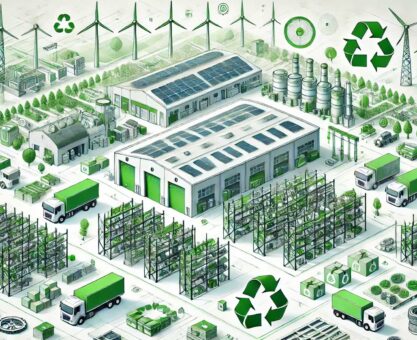04/09/2015
Setting out the aim to make your company more environmentally friendly is not only healthy for the planet but also very healthy for a logistics and transportation business as well…
Reducing your fuel costs for example obviously makes great financial sense and it also has the benefit of helping to differentiate you from other field based companies in what are becoming increasingly competitive markets across the board. For example, image conscious high street retailers are much more likely to partner with an e-commerce deliver partner that shares their (often very public) environmental values, and in fact this is a trend that is mirrored by consumer behaviour also.
According to a recent Eurobarometer survey 55% of consumers said they take time to understand the environmental impact of the products they buy. Further to that over three quarters of consumers said they would pay a premium for greener goods. It is natural that this powerful sentiment would flow through the supply chain and impact on a retailer’s choice of transportation provider for their ecommerce offerings.
Whilst environmental issues have been a large part of the conversation for many years, it is only in today’s world with the advancement of tablets, smart phones, white boards, the cloud, including facilities such as dropbox and skydrive, which are all able to communicate openly with each other, that a truly sustainable approach can now be grasped.
Adopting transport technology and with innovations in the mobile world, greener credentials are more attainable than ever; with the ability of SatNav, job scheduling, signature capture working on new devices with NFC and RFID capabilities encased in a more consumerist look and feel than previous rugged enterprise products means greater user adoption, think Honeywell Dolphin Black to Motorola TC55.
So moving towards greener working i is now an obvious progression for the transport and logistics industry to take under serious consideration.
As well as improving productivity and cost savings, using an electronic proof of delivery system, mobile field service management or a real–time job scheduling and route optimisation system for instance, has been shown to deliver a significant improvement when reducing physical costs i.e. of consumables and labour costs. It also has a significant impact on reducing CO2 emissions and the carbon footprint of logistics operators.
The following results demonstrate the savings achieved by a medium sized logistics company, “XYZ Courier Services Ltd” using actual data.
“XYZ” operates a cloud based technology system to manage its fleet of 2,000 full time drivers. Before introducing mobile data to its fleet of drivers, the company had to provide each driver with a 15 page printed manifest showing their daily workload and schedule.
Over the course of a year, this amounted to 7,800,000 individual pages, or 15,600 reams of paper. The cost of purchasing paper equates to £55,000, print toner costs amounted to £110,000, which means that over a three year period the company spent half a million just on paper and toner alone.
Although financial savings are a factor in the decision to adopt mobile data that improves greener credentials, there are also carbon costs to appreciate, due to the energy and environmental impact of the printing process. Taking into account the amount of paper produced over a three year period for the paper manifests equated to 648 tonnes of CO2 emissions, which has now been saved.
The transportation of raw materials and finished products are a significant source of carbon emissions in the supply chain. For some companies, logistics can be the primary component of supply chain carbon emissions. The Department of Transport found road transport accounts for 21.7 percent of the UK’s carbon emissions; of that, 19.8 percent is attributable to heavy goods vehicles (HGVs) and 15.2 percent to vans. The government is aiming to position the UK at the global forefront of ultra-low emission vehicle (ULEV) development, manufacture and use, and has a vision for ‘almost every car and van’ to be zero-emission by 2050. Furthermore, by implementing effective route optimisation that ensures the most optimal route is taken by a driver will result in less driven miles and fuel reduction.
What this analysis highlights is that for a mid-sized logistics or delivery company, introducing mobile data technology such as ePOD to the drivers has had a significant impact not just by reducing costs, but also by improving the company’s overall carbon footprint. And these cost savings are relevant to smaller and larger organisations alike.
Not only will changing to transportation and logistics partners with greener credentials help meet a company’s corporate social responsibility and environmental policies, by utilising transport technology allows a company to get a clearer picture of deliveries, scheduling, managing peak times; reviewing carbon emissions, driver behaviour – in readable, legible reports based on date and time driven events. This means more power through real-time knowledge transference, without having to sift through volumes of paperwork.
A business can never entirely eliminate its environmental impact, but that should not be a reason to not take advantage of the technology available to reduce it. Especially when having a green approach to your transport fleet helps to achieve positive environmental and financial goals.















